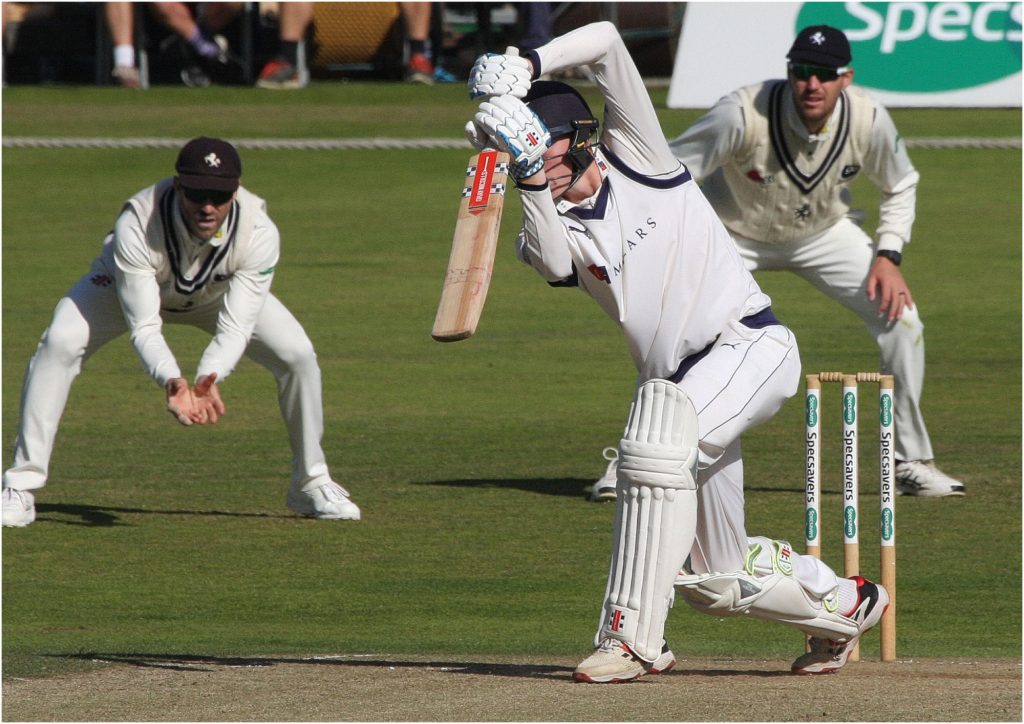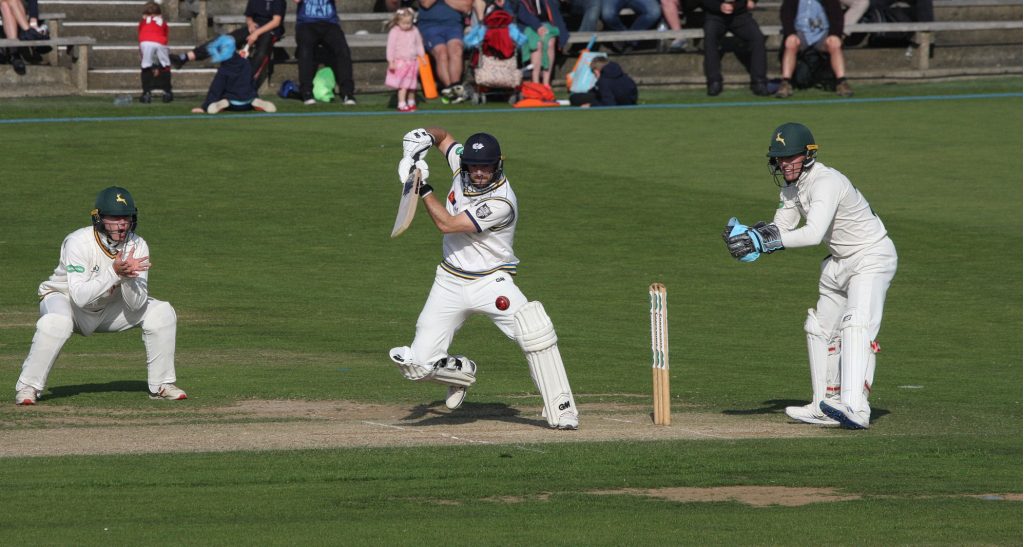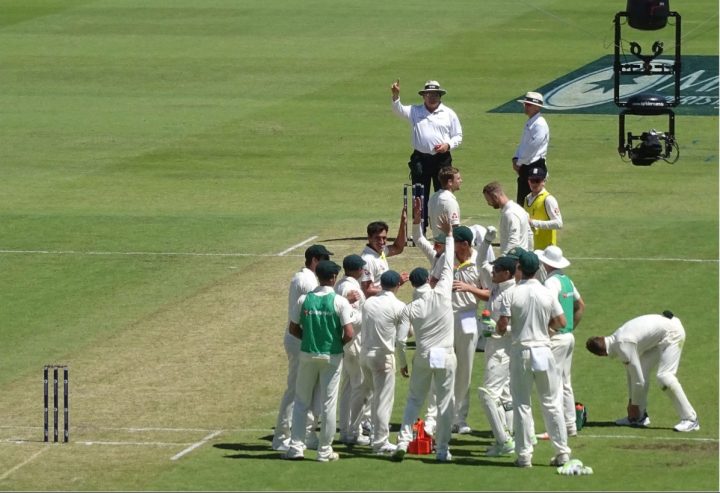Today we introduce guest writer Sushain Ghosh to TFT. He’s a cricket obsessive from India who’s developed an unlikely fascination with the English domestic game through… fantasy cricket games. I enjoyed this submission because it reminded me just how unique and special the county championship is. The diversity and charm of the competition is second to none. We’re lucky to have it.
The reappearance of the BBC page for live cricket scores in the ‘most visited’ section of my web browser is due to one thing – the start of the English domestic season. This year, as with the last, I’ll be playing a season-long fantasy game for the County Championship. After one full season – and as of this writing, two rounds of the second full season – of scrambling to make a well-balanced team on time and under budget, of frantically tracking down official tweets for the latest team news, of performing mental calculations for expected fantasy points with greater alacrity than I ever mustered for arithmetic, of desperately shuffling through streams to find my bowling captain plugging away in the last hour to prise out the wickets that will accrue to me precious bonus points before the teams shake hands, I’ve come to an overwhelming, undeniable conclusion about fantasy County Championship.
It has changed my life.
The basics of fantasy sports are simple enough – pick players involved in a particular match (or round of matches) and get points in the fantasy game based on how they perform in the match. Depending on the platform, players might have the option of playing daily games and/or a season-long game, with the latter involving the transfer of players in and out between rounds.
While the truth is more complex than casuals flocking to daily games while the diehards play the season-long version, consider for a moment the duration of the Championship and the sheer number of variables involved in team selection each round – the numerous counties and the form of their players, injuries, arrival of overseas players, emergency loans, departures for international duty, and so on. At six months long, and with its cast and calendar in constant flux, fantasy County Championship demands a commitment bordering on the obsessive.
Consequently, the depth of a player’s emotional investment in this weird and wonderful game yields vast knowledge about the Championship and its cricketers, about fantasy cricket, and, most interestingly, about the ways in which knowledge derived from one fills the knowledge gaps in the other. Fantasy County Championship, in other words, has taught me a lot about county cricket – or at least, made me more sensitive to things I subconsciously grasped but rarely acknowledged.
In some respects, of course, the knowledge particular to fantasy cricket is an intuitive carryover from the real world – all-rounders are a two-for-one deal with their combination of batting and bowling points, spinners become more effective as the game goes on etc. But watching the distribution of fantasy points in real time across four days reveals fascinating and sometimes unexpected clusters of measurable activity in English first-class matches.
Take wicketkeepers, for instance. Given that a number of platforms tend to reward fielding quite generously, the humble stumper is a veritable point machine in fantasy County Championship. The logic of why they make such attractive options seems entirely reasonable, too: if you assume that a Championship game will produce a decisive winner, there are only so many runs that will be scored in the match. For a team batting in the first innings, each run above five hundred has rapidly diminishing value when weighed against the time expended in making them, especially considering interruptions for weather.
However, the number of wickets on offer will still be 20 (or near enough) – and all would have to fall to produce the assumed result. Being out caught behind is relatively common in this competition – playing the game makes one aware of the remarkable extent to which wicket-keepers are involved in a team’s quantifiable output in every match. Indeed, so great is their involvement in dismissals effected that their runs are often but a bonus on top of points from catches, stumpings, and run-outs.
It is, in fact, the role of the wicket-keeper, rather than any individual, that is truly valuable. Since the output of glovework has a tenuous connection with player value – outside of truly sketchy wicket-keepers – an inexpensive wicket-keeper will often match the performance of an expensive wicket-keeper (unless the latter is vastly superior with the bat) – in purely statistical terms, it is unsurprising to see Harry Swindells, Brooke Guest, and Michael Burgess keep pace with Ben Foakes. Moreover, a team’s runs are unlikely to be distributed equally among the batters and thus, a wicket-keeper with a modest haul of 30 runs and four catches will likely outperform most batters in a given match.
These relatively confident assumptions are partly down to the rhythm of Championship matches and the familiar ways in which they tend to unfold. It can be overwhelming for the new viewer, but the busy schedule is a plentiful source of data to reliably identify patterns of play, project likely outcomes, and become confident in how the competition as a whole tends to lurch from innings to innings and match to match in predictable ways.

The most compelling change of pace in the Championship is undoubtedly the lower-order blitz. These late flurries and counter-attacks are a regular feature of county games and make for fantastic, entertaining cricket, usually carried out by daredevil bowlers, aggressive all-rounders, and enterprising wicket-keepers. This assault on fatigued opponents sparks a drifting encounter into life and turns the dynamic of the game on its head – now, batting points are scored by bowlers.
(As an aside, the most incredible innings of this type I’ve seen in recent years is Jamie Overton’s 120 off 92 deliveries at number ten for Somerset against Warwickshire in the 2020 Bob Willis Trophy. Replying to Warwickshire’s 121, Overton’s 15 fours and six sixes elevated Somerset from 226-8 to 406-9 when he was caught behind off Tim Bresnan. It was his maiden first-class hundred, and I’ve since lived in hope that he may produce an encore).
The lower-order blitz is the distillation of county cricket into pure exhilaration, an enormous and violent reversal of the slow and seemingly inevitable termination of the innings, detaching fantasy cricket from cerebral number-crunching and hitching it to the unbridled ecstasy of watching the line go up – and sometimes much more. In 2021, the match between Kent and Glamorgan at Canterbury was notable for the extraordinary performance of Darren Stevens. At one stage, Kent were 128-8 before Stevens took over; in all, he plundered 15 fours and 15 sixes in his innings of 190 from 149 balls and helped his side to a total of 307.
Having captained Stevens that round, I counted the points as they rolled in, clapping like a performing seal at each six. It began as a celebration of the line going up, the raison d’être of fantasy sports, but at some point, the line disappeared and I, too, was caught up in the Stevens wave.
While in theory this whole enterprise demands great knowledge, the Championship’s best players are obvious to anyone with even a passing familiarity with the English domestic game. They are, however, the most expensive and most highly owned assets – budget issues make it impossible to cram all of them into your team and their ownership is so high that the ‘gains’ from a Stevens, Simon Harmer, or Chris Rushworth are not gains in any realistic sense as their points are far from unique.
They are, of course, wonderful to watch – and it speaks to the value of the Championship that players like Kyle Abbott, Marnus Labuschagne, and Cheteshwar Pujara ply their trade here. At the same time, however, it does mean that any advantage from a Tim Murtagh or Craig Overton fast disappears in this market. This phenomenon becomes especially important in a season-long game, with all players on the lookout for dependable assets to set and forget – and more importantly, assets who allow them to use their limited transfers to put out fires elsewhere.
When there’s as little wiggle room in team selection as there is in fantasy County Championship – it takes a truly courageous player to swing against a fire-breathing Harmer – the next best thing is to attack specific situations and match-ups for gains. Most fantasy platforms do not permit changes while the match is in progress and so one becomes increasingly adept at identifying how matches are likely to unfold beforehand based on some clear signals – a highway at Surrey, a game in the north in April – and targeting them with the appropriate squad changes.
The varied conditions and matchups around England no doubt make the Championship delightfully eclectic, but actually using that knowledge is especially satisfying. There are, for instance, better options than Harry Duke, but not all keep wicket to Matthew Fisher, Steven Patterson, Jordan Thompson, and Haris Rauf.

The other kind of value comes from taking advantage of player (mis)classifications. Most fantasy games set a floor and ceiling on the number of players of each type that you can have in your team – batters, bowlers, all-rounders, and wicketkeepers. The roles in real cricket are, of course, more fluid – especially at first-class level – but it does mean that the rigid classifications in fantasy games allow players to take advantage of casting mistakes.
A classic example is James Bracey. A top-order batter who kept wicket but was classified as a batter, selecting Bracey allowed players to squeeze margins – to accumulate the benefits of keeping wicket in addition to the benefits of batting at the top of the order. There is an illicit thrill of snaring bowling points from designated batters or keeping points from designated all-rounders – a sense that one has strayed beyond the limits of the game into the forbidden, gleefully manipulating the fluidity of player roles in the real world against the inflexible taxonomy of fantasy cricket, a self-congratulation of one’s cleverness in successfully squeezing the margins of the points system to wring out an advantage.
But more than smug self-appreciation, the whole exercise unexpectedly opened my eyes to the viability of building competitive red-ball squads at county level with these Swiss army knives. Last season, in search of cost-effective batting options, I stumbled upon Glamorgan’s David Lloyd – listed as a batter, but bowling an average of 12 overs per game, effectively an extra all-rounder beyond the number permitted by the game.
As Lloyd squeezed the margins – he finished 2021 with 21 wickets at 26 – and I collected my ill-gotten gains, I began searching for similar bargains elsewhere at Glamorgan. Enter Callum Taylor, a solid budget option with the bat and one of the very few at that price with the bonus of bowling points and guaranteed to play each game. Together, Lloyd and Taylor dramatically elevated my perception of Glamorgan – previously an underdog on the margins, unworthy of fantasy consideration, but now a rich seam of multi-skilled and undervalued handymen.
Fantasy County Championship also alerted me to the gems toiling in the English first-class system. Outside international cricket and franchise leagues, the distance between us and the cricketers diminishes – they feel more human, and I would hazard that we feel a greater sense of loyalty for passionately following them away from the bright lights and consequently a greater sense of empathy with their successes and failures.
Last season, when Ryan Higgins enjoyed a fine start to the campaign and began stirring up the England conversation, I, who got the all-rounder in my team pretty early on, chanced upon a piece by Matt Roller entitled “Ryan Higgins: The Ben Stokes injury replacement hiding in plain sight.” It was the moment when my interest in the Championship crystalised into fandom; I felt included in conversations about the stars of the Championship, carrying a slightly haughty air, even, for having believed in and backed his talent before the press lumbered to this Higginsian revelation (note to press: tongue is firmly in cheek).
Equally, though, fantasy cricket has opened my eyes to how marginalised players can become in first-class games. It’s an experience that’s difficult to empathise with as viewers – our focus naturally gravitates towards the action – but fantasy cricket bridged that gap for me better than anything else. In the opening round of the 2022 season, Dominic Sibley was bowled for a first-ball duck by Reece Topley and was promptly left twiddling his thumbs for the rest of the game as Warwickshire ran up 531 in response to Surrey’s 428-8 declared. This was followed by Surrey compiling 43-0 before the teams shook hands. Sibley did not bowl and took no catches. At various points during this futile draw – my interest in the match arriving only on day two and swiftly extinguished by Topley’s fateful delivery – I wondered if Sibley felt the same frustration I did watching the runs being piled on while he made none of them.

Ultimately, in my experience fantasy games are an additional layer of interest on top of the excitement of following the Championship as a whole, even though I arrived at this interest in reverse – first the fantasy game, then the real league. I should clarify here that with my long experience playing International Cricket Captain, the Championship was hardly unfamiliar. If anything, I would have felt completely unprepared for the six-month commitment of season-long fantasy County Championship had I not several happy video game memories of the English domestic season.
But what fantasy cricket did for me was make the current county scene feel so real, its ebbs and flows so immediate – and very unlike the impossibly remote world of sticky dogs and luncheon intervals from the 1930s I’d read about so much. Now I know how it feels to have my emotional well-being depend on an end-of-season Warwickshire v. Somerset game (it was last September; I forgot Craig Overton was playing this round, so he wasn’t in my team; he took five wickets; I was wrecked because of his high ownership despite the fillip of Pope’s 274).
But there are moments when the excitement of the Championship takes over, and everyone watching becomes wrapped up in the spectacle. Last May, live on Sky, Surrey and Middlesex fought out a thrilling draw at The Oval, all four results at least vaguely on the cards as the match hurtled to its final stages. Middlesex’s pursuit of 290 in the fourth innings was anchored by a splendid Nick Gubbins hundred, but Rory Burns had his fielders spread out and a late burst from Kemar Roach, including the wicket of the centurion, put the brakes on the run chase. The possibility of defeat still existed, and so the visitors took the draw, shaking hands on 250-6 from 56.3 overs.
It was a marvellous game, closely fought most of the way and exploding into pure theatre on the final day. To say that my concern for the fantasy implications of this match melted into the background would be to imply that I remembered there were fantasy implications to be concerned about – the exhilaration was all-consuming.
By keeping tabs on each fixture, one thing I’ve learned is that the Championship is full of spectacular matches and moments like this – and they often come about unexpectedly; even though lower-order blitzes happen regularly, and you know they happen regularly, good luck trying to predict one.
Like the aforementioned Stevens innings, like Essex’s defeat of Somerset by one wicket this season, Surrey v. Middlesex reaffirmed the always-active (and frequently fulfilled) promise of the Championship to throw up bonkers matches and moments. To sum up, I came for the Higgins bowling points, stayed for thrillers at Taunton, and came away with nuanced arguments for why the Championship shouldn’t be three divisions.
Sushain Ghosh









I used to play this but stopped because I see dubious agendas behind it:
1) It preps the way for franchises – teams have no intrinsic nature but are just mix-and-match combos of players chosen by an omniscient selector (in reality, not you or me).
2) It encourages betting – anyone else notice how fantasy enthusiasts can’t wait to tell you when they won some money on a move they made?
3) It gets people living in a state of unreality. Fantasy = Metaverse.
Avoid.
I’ve done fantasy football for years and still do the Sun Dream Team, without much increased success, but the variables involved in your average county game are much more difficult to quantify, including presumably the weather and call ups to internationals on top of injuries and form peaks and troughs.
In summary the whole cricketing caboodle seems a nightmare to predict, especially with so many different formats to include.
Great article!
I enjoy Fantasy Cricket and find following each round of games more enjoyable for it
Thanks for this Sushain. I used to play Fantasy Cricket but I kept losing because I didn’t have the time to update my team. I really enjoyed it though. I think the County Championship, and cricket in general, is ideal for fantasy games because it’s so stats based. It certainly brought interest to other fixtures when my team (Worcs) weren’t playing. The points totals of individual players are also great for identifying undervalued pros on the circuit. It also exposes some of the overrated ones lol!
Interesting article, Sushain, but when I saw the fantasy cricket headline I presumed you would be writing about the Hundred !
Thanks, Sushain for writing a great article base on your real-life experience. This is inspiring for us I hope you will share more interesting cricket information I am waiting for your next post.
Hey Sushain,
This article gave some ideas about the Country Championship.
I really enjoyed by reading your article
There are plenty of predictions on each variety of game.
But the Country championship was quite different to read in your article.
No one, it’s just an article rather than that you have shared your own experience and that makes you more interested and boosted up.
The great news is this has changed your life.
Thanks for this valuable information.
You ve published some amazing cricket blogs, keep it up brother